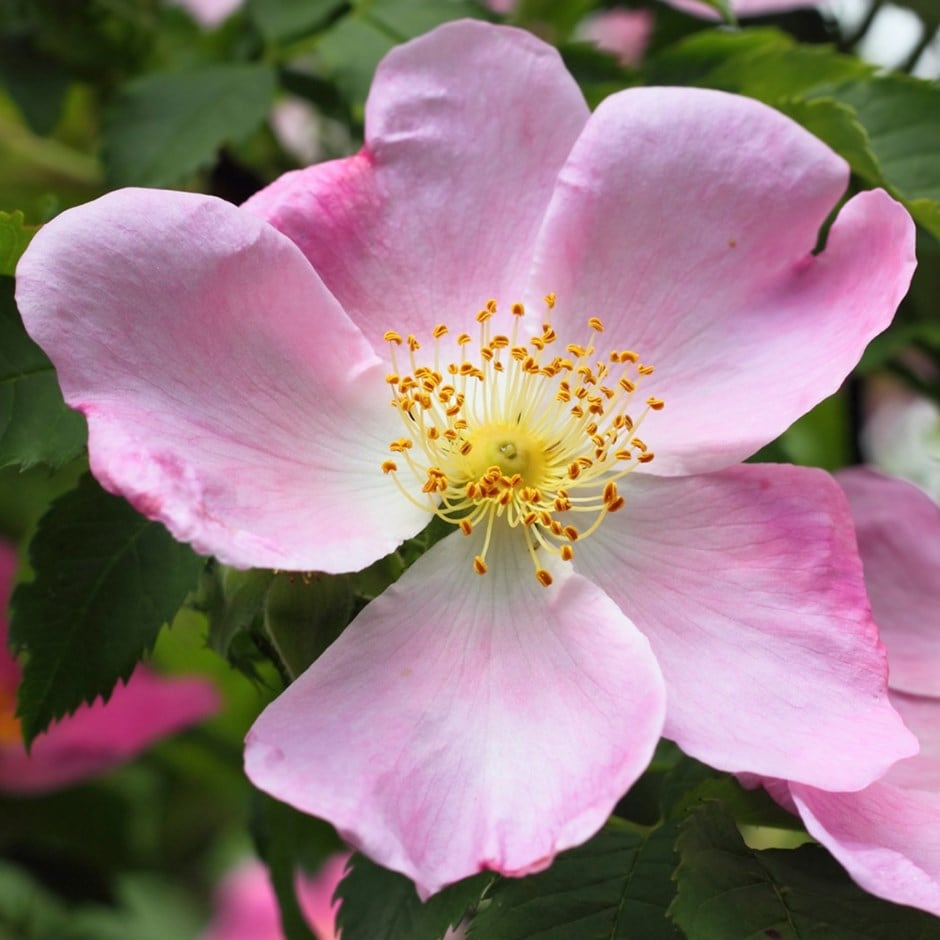Rosa canina
dog rose hedging
This rose is deciduous so it will lose all its leaves in autumn, then fresh new foliage appears again each spring.
- Position: Full sun or partial shade
- Soil: Moderately fertile, moist but well-drained soil
- Rate of growth: Fast
- Flowering period: July to August
- Hardiness: Fully hardy
Tough, tolerant and fast growing, the sprawling stems of this native rose will form a thick impenetrable hedge in record time. The pink-flushed, white flowers have a lovely scent and appear throughout summer. As they fade, glossy red fruits (hips) form, which add interest well into autumn. A wonderful addition to a wildlife-friendly garden as the hips are very attractive to birds. The prickly stems however will make unwanted visitors think twice before they try to cross. Happy and undemanding in most settings, it is particularly useful in coastal areas.
Our bare root hedging range is a very low cost way of planting a hedge. These plants are only available to buy and plant when dormant (November- early April). These plants, with known seed provenance, are grown in rich Herefordshire soil to give them the best possible start in life so they are raring to go by the time they reach you.
Our plants are 1 year old (1+0) which means they have been grown for 1 year in the seed bed. The plants are lifted and graded at between 40-60cm tall, which is a good size to plant hedges at to get good establishment.
To find out more about how to plant a hedge, click here
Our bare root hedging range is a very low cost way of planting a hedge. These plants are only available to buy and plant when dormant (November- early April). These plants, with known seed provenance, are grown in rich Herefordshire soil to give them the best possible start in life so they are raring to go by the time they reach you.
Our plants are 1 year old (1+0) which means they have been grown for 1 year in the seed bed. The plants are lifted and graded at between 40-60cm tall, which is a good size to plant hedges at to get good establishment.
To find out more about how to plant a hedge, click here
For best results, plant these bareroot plants out as soon as they arrive into well prepared soil. As the flowers appear on stems that have grown in the previous year, pruning should be kept to an absolute minimum if you are growing them for a good display of flowers and hips. To keep it looking fresh though, you can cut back a couple of the older stems to around 30cm above ground level, from late autumn to early spring.
As most shrub roses tend to flowers best on older stems, they only need a little light formative pruning. Hard pruning should be avoided unless absolutely necessary as it can often ruin the plants shape. The best time to prune is in late summer after they have finished flowering. While wearing tough gloves, remove dead, damaged, diseased or congested branches completely. If the centre of the shrub is becoming congested, remove one or two of the older stems to their base. If they have become too leggy, then you can often encourage new growth to form by cutting one or two stems back to within 10 - 15cm above ground level.
As most shrub roses tend to flowers best on older stems, they only need a little light formative pruning. Hard pruning should be avoided unless absolutely necessary as it can often ruin the plants shape. The best time to prune is in late summer after they have finished flowering. While wearing tough gloves, remove dead, damaged, diseased or congested branches completely. If the centre of the shrub is becoming congested, remove one or two of the older stems to their base. If they have become too leggy, then you can often encourage new growth to form by cutting one or two stems back to within 10 - 15cm above ground level.

